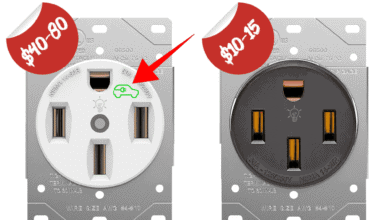Difference Between Microprocessor and Microcontroller
Main Differences between Microprocessor and Microcontroller
“What is the difference between microprocessor and microcontroller?” A simple and basic electronics question, yet people still confuse these two components for the same thing.
What is a Microcontroller?
A microcontroller is a mini-computer on a single semiconductor IC (integrated circuit) chip. It is a complete computer and has all the essential components needed on a single chip such as the processing unit, ROM, RAM, I/O ports, serial ports and Timers, etc.
It does not need external components to perform a task which makes it a perfect candidate for embedded and compact devices in industries. Most common series of the microcontroller are PIC, 8051, AVR, etc.
What is a Microprocessor?
A microprocessor is an IC that has only CPU (Central processing unit) without other necessary components inside the (IC) packaging. Its packaging does not contain RAM, ROM and other components required to perform a task. That is why it needs external components to complete a task.
Due to this reason, the devices made from microprocessors are bulkier and power consuming but they have up-gradable memory and high processing capacity for performing complex tasks such as games, website and software development, etc. it functions are unlimited.
- Related Post: Difference Between CPU and GPU – Comparison
Differences Between Microprocessor and Microcontroller:
| Microcontroller | Microprocessor |
| It is a mini-computer capable of performing a task on its own. Examples: 8051, 8951 etc. | It is the central processing unit of the computer. Examples: 8085, 8086 etc. |
| It has necessary peripherals inside the chip like RAM, ROM, etc that is why it is called SoC (system on chip). The functional units are registers, CU, ALU, RAM, ROM, IO Ports, DAC, ADC, Counters and Timers. | It needs external RAM, ROM to perform a task. The functional units are registers, CU and ALU etc. |
| It is used in the embedded system and specific applications. | It is used in computers as it is the brain of a computer. |
| It is used in compact devices because it does not need external components. | It needs external components thus the devices made it are bulkier. |
| Due to a few numbers of external components, the power consumption is very low. Thus it can be powered using batteries. | The external components require extra power to perform. Thus they are not suitable to run on batteries. |
| It has an internal fixed amount of memory that cannot be upgraded. | The external memory is upgradeable and can be easily varied to meet the task. |
| Due to on-chip flash and memory, they are fast in loading the program and instructions. Hence fast execution at startup. | Due to external memory, the programs take some time to load which makes it relatively slow. |
| The microcontroller also has a power-saving system for the idle condition that decreases the power consumption | The microprocessors do not have the power-saving function, they consume energy in idle condition. |
| Its processing speed is 8Mhz to 50Mhz. thus it cannot be used for complex tasks. | While the microprocessor processing speed is above 1Ghz. It can perform complex tasks. |
| The MCU can support upto 720p High-definition video. | It can support above 720p high-definition video. |
| It can support USB 2.0 with max speed of 480 Mbits/sec | While it can support USB 3.0 with 5 Gbits/sec speed. |
| The MCU is application-specific i.e. it is designed for performing a single specific task. | It is designed to perform complex and complicated tasks to utilize its high memory. |
| It is cheap and having low power consumption thus they are perfect for cost-effective, battery-operated electronics. | It is expensive and power-consuming having high processing speed thus they are perfect for high performance of complex tasks. |
Difference based on External Peripherals
The main difference between a microcontroller and microprocessor is the presence of necessary peripheral or components like RAM, ROM, EEPROM, etc inside a single IC chip.
Due to the compact design of microcontroller, they are used in mini portable electronic gadgets, toys and devices. While the microprocessor-based systems are bulky and heavy due to the external peripheral, they are not suitable to be used in small devices.
- Related Post: Difference Between RAM and ROM – Comparison
Differences based on Power Consumption
The microcontroller has a built-in power-saving feature and the internal peripheral also factors in to cause of low power consumption. The external peripherals used for microprocessors increase the power consumption of the system including the lack of power-saving feature. Thus the MCU based devices are powered using batteries with long life expectancy, while the MPU based devices are not suitable to run on stored powered.
Another difference is the requirement of multiple voltage rails. A microcontroller needs a single voltage rail. However, the external peripherals connected with the microprocessor need different voltage levels. Thus they need a complex power supply that can provide power rails having different voltage levels.
The Microprocessor-based systems are relatively expensive due to the need for external RAM, ROM, etc. while the microcontroller is a single inexpensive chip that can perform the task on its own.
Differences based on Limited and Upgradeable Memory
Quick note; Internal memory is faster than the external memory because it is embedded within the semiconductor chip.
The MCU’s internal flash memory speed is faster than the MPU’s external memory. Thus the MCU quickly loads and executes the program code at startup. The MCU based devices run immediately while the MPU based system takes a while during startup.
The microcontroller has a built-in fixed limited flash or memory which cannot be upgraded. Where the MPU based system’s memory can be upgraded to meet the task requirement. This gives an edge to the microprocessor-based system to outperform the microcontroller in performance and executing complex tasks.
The MCUs are designed for performing a specific task that is why they are known as ASIC (application-specific Integrated circuit). It does not need high processing speed and memory to perform a single task. While the microprocessors are general-purpose devices that can handle tasks that need a huge amount of resources and can provide better performance.
Differences based on the processing speed
Processing speed-wise MPU is better than the MCU. The former’s processing speed is above 1GHz to 4GHz while the latter’s speed is about 8 MHz to 50 MHz. Microprocessor works much faster and can perform complex tasks faster like audio, video, animation content, editing or designing, etc.
Choosing between Microcontroller and Microprocessor
The selection between a microcontroller (MCU) and Microprocessor (MPU) depends and affects your project. It is the first crucial step in its development.
- The MCU chip incorporates CPU (central processing unit) as well as the memory and necessary peripherals while the MPU chip only has CPU. So a better choice for size is MCU
- The best MCU can handle a 720p High-definition video. For the video above 720p, MPU is a better choice.
- The MCU can support USB 2.0 has a data transfer speed of about 12 Mb/sec to 480 Mb/sec. USB 3.0 provides a better speed around 5Gb/sec which needs the high processing power of the MPU.
- The MCU is slower than MPU so if you need to process a huge amount of data quickly, then MPU is a better choice.
- GUI (Graphical User Interface) can be implemented using both MCU and MPU. But MPU is a better choice for developing high-resolution GUI.
- MCU’s power-saving feature and low power consumption makes it perfect for battery-operated products. The energy-saving during idle conditions increases the battery life by ten folds.
- The memory of MCU is limited. While the MPU’s upgradable memory is best suited for applications that utilize a large amount of memory.
- The MPU needs an operating system (OS) while MCU does not need an operating system. It straight-up loads the program from its firmware. The OS needs extra processing speed that MCU lacks.
The conclusion of the above-mentioned points is that MPU is a better choice for processing a large amount of data, having high processing speed, supporting video resolution greater than 720P (including high-resolution GUI) and supporting USB 3.0.
MCU is a better choice for battery-operated, compact and inexpensive product development where its job is to utilize its low memory to control sensors, actuators and motor to perform a specific task cost-effectively.
Your first choice of selection between microcontroller and microprocessor should be the microcontroller. Because almost any project idea can be implemented using a microcontroller like Arduino etc. cost-effectively.
Although some projects may need a microprocessor to perform complex tasks like speech recognition, facial recognition (Image processing), artificial intelligence (AI) that uses a huge amount of memory.
You can also use both in a project separately to perform separate functions effectively. Like controlling the sensors and motors in a robot using MCU and processing the large amount of data from camera and microphone using MPU.
Related Posts:
- Difference Between Capacitor and Supercapacitor
- Difference Between a Battery and a Capacitor
- Difference Between EMF and MMF
- Difference Between Conductor, Semiconductor and Insulator
- Difference Between Voltage and EMF?
- Difference Between Real Ground and Virtual Ground










Chips maker
I love education you are offering here
Me too also love education .
What is the advantage of 60Hz power over 50Hz power?
Please write a blog on this question and inform me.
good